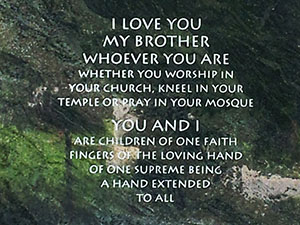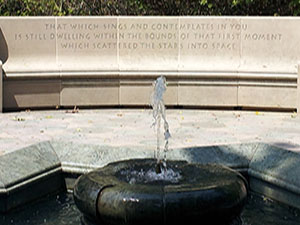The true wealth of a nation lies not in its gold or silver
but in its learning, wisdom, and in the uprightness of its sons.
Kahlil Gibran (1883 – 1931)
Kahlil Gibran
Kahlil Gibran, artist, poet and writer, was born in B’charre, Lebanon and immigrated with his family to the United States in 1885.
In 1904 Gibran had his first art exhibition in Boston. From 1908 to 1910 he studied art in Paris with August Rodin. In 1912 he settled in New York, where he devoted himself to writing and painting. Gibran’s early works were written in Arabic, and from 1918 he published mostly in English. In 1920 he founded a society for Arab writers, Mahgar (al-Mahgar). Among its members were Mikha’il Na’ima (1889-1988), Iliya Abu Madi (1889-1957), Nasib Arida (1887-1946), Nadra Haddad (1881-1950), and Ilyas Abu Sabaka (1903-47).
Gibran died in New York on April 10, 1931.
Among his best-known works is The Prophet, a book of 26 poetic essays, which has been translated into over 20 languages. The Prophet, who has lived in a foreign city 12 years, is about to board a ship that will take him home. He is stopped by a group of people, whom he teaches the mysteries of life.

Kahlil Gibran Memorial and Meditation Garden
3500 Massachusetts Avenue, NW, Washington, DC 20008, across from the British Embassy.
GPS Coordinates: 38.919476-77.062484
The Kahlil Gibran Memorial Garden is free and accessible 24 hours, 7days a week.
The Kahlil Gibran Memorial Garden was founded in 1991 to celebrate the 100th anniversary of the poet’s birth. The Memorial Garden was designed by renowned sculptor Gordon Kray.
Upon the road of Zaad a traveler met a man who lived in a nearby village, and the traveler, pointing with his hand to a vast field, asked the man saying, “Was not this the battleground where King Ahlam overcame his enemies?” And the man answered and said, “This has never been a battle-ground. There once stood on this field the great city of Zaad, and it was burnt down to ashes. But now it is a good field, is it not?”
And the traveler and the man parted. Not a half mile farther the traveler met another man, and pointing to the field again, he said,”So that is where the great city of Zaad once stood?” And the man said, “There has never been a city in this place. But there was a monastery here, and it was destroyed by the people of the South Country.”
Shortly after, on that very road of Zaad, the traveler met a third man, and pointing once more to the vast field he said, “Is it not true that this is the place where once there stood a great monastery?’ But the man answered, “There has never been a monastery in this neighborhood, but our fathers and our forefathers have told us that once there fell a great meteor on this field.”
Then the traveler walked on, wondering in his heart. And he met a very old man, and saluting him he said, “Sir , upon this road I have met three men who live in the neighborhood and I have asked each of them about this field, and each one denied what the other had said, and each one told me a new tale that the other had not told.” Then the old man raised his head, and answered, “My friend, each and every one of these men told you what was indeed so; but few of us are able to add fact to different fact and make a truth thereof.”
from The Wanderer ,”The Field of Zaad,” by Kahlil Gibran



